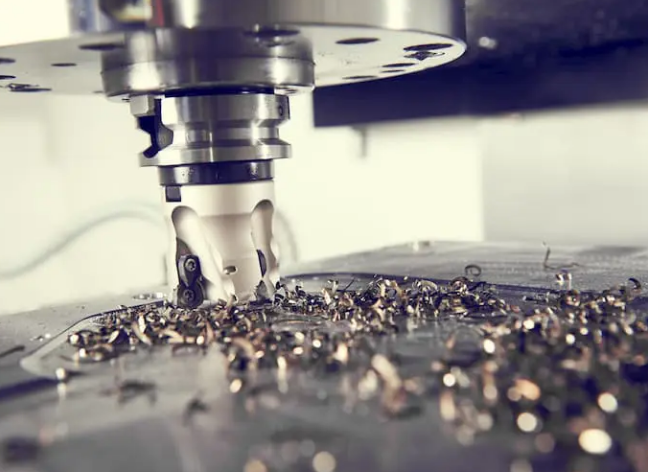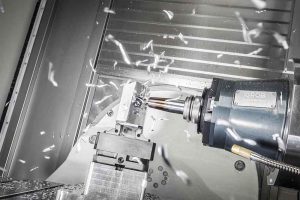CNC machining offers greater precision with tolerances as tight as 0.01 mm, operates continuously for higher productivity, can easily handle complex designs, and has higher initial costs but reduces labor needs. Traditional machining is more manual, less consistent, and often slower.
Control Method
CNC is an acronym for Computer Numerical Control, which signifies the use of computer-based systems to control the operations and movement of machine tools. Therefore, CNC machines execute programmed operations with minimal input by the operators. As a result, manual labor is significantly reduced while the speed of production is markedly increased. At normal circumstances, a typical CNC machine can produce parts more than 50-70% faster than the traditional manual machining. For example, a CNC mill might produce a component that may necessitate about 10 changes of mills in a manual setting.
In substitute, however, the same part can be produced in a single integrated operation with no alterations or modifications. In contrast, manual machining is primarily reliant on the competence and experience of the operators, who manually control the machinery. Consequently, due to the increased need for manual setup, measurements, and modifications, the rate of production is significantly lower. As such, a manual lathe may require twice as long to produce the same part as a CNC machine. Moreover, the precision of manual machinists may also be more variable, with the average individual having an error tolerance of about 0.1 mm.
In contrast, CNC machines provide an accuracy that is between five to ten times more precise with only a 0.01 mm room for error. For example, in the production of automobile engine parts, CNC machining may produce components in less than a few hours that may take days to manually machine to the necessary precision needed for performance and safety. Additionally, the adoption of CNC technology also presents differing cost implications.
Although the initial investment is much more significant in CNC machinery, the overall production cost is considerably decreased as a consequence of the increased operational scale and reduced waste. Manual machining production volumes might be cheaper to implement, but in the long-term, they may generate additional costs as a result of the slower production rate and higher value of manual labor.
Precision and Reproducibility
CNC machining is particularly exceptional for its precision and ability to create parts inperfect reproduction. In this context, recording differences between the two techniques demonstrate that CNC machining relies on digital blueprints while programmed codes ensure the creation of machine parts. The difference makes the relative advantage that CNC machining has in producing identical parts. In the case of aerospace technologies and medical devices, a 0.01 mm difference might make the implant failin vivo. At the same time, the cutting tools rely on human interaction to determine the preciseness of the cut, with possible differences between identical parts in micro-measurements.
Any difference is likely to contain serious consequences for such industries as defense, aviation, and others as instrument parts have to be identical to ensure the normal operation of the respective machinery. The production of identical parts in manual machine requires high precision and control measures to ensure that the machine operator does not deviate from the positioning of the cut. CNC machining allows a success rate of one to thousands without ever making any change in the code.
The reminds the example of the aerospace industry and the machining tolerance that ensures a 0.0005-inch maneuver.. Devices always require strict fitting to work properly. The possibility of error in each of the thousands of parts created manually is the issue that CNC machining solves by adhering to the digital blueprint exactly. CNCmachining often does not require an extended process of trial and error to ensure that each item created is flawed no more by the cut and code difference.
Speed and Efficiency
The biggest advantage CNC machining has over the traditional method would be its speed and efficiency. There are ways providing the details about how fast CNC machines are, but it is quicker or time-efficient than conventional machining. The biggest reason is that overclocking, which refers to working without a break throughout the day. The only delay that this type of machine can have is its periodic tool switch for efficiency or maintenance. This ability allows CNC machines to be productivity-geared, which is beneficial in the case where mass production is required.
For example, when one considers producing one batch of housings for certain electronic devices, such as cases for smartphones or frames for laptops, the CNC machine would be able to carve through the hundreds of units in no time. The manual machine, on the other hand, would require the same amount of time and effort to complete just one unit. At the same time, assuming that a particular device itself would require a whole batch of these parts only a few times a year, the amount of time wasted is significant. Furthermore, similar efficiency can be seen in the cutting process – complex patterns can be produced in minutes by modern CNC routers, whereas the same procedure via a manual machine would take hours.
Another advantage of such machines would be their time-efficiency when it comes to the time spent on setting a new run of production. CNC machines would have a faster switch because they would be software-based and the physical change in them is limited to only changing the “heads” of the tool or a tool, as well as uploading a new program. In the modern example, a batch of specific parts used in automobiles is produced by a CNC machine.
The manufacturer receives an order to produce tool sets for different automobiles. Therefore, all it needs to do is write a paper with the requirements, sufficiently different from the already-established program, and find the new tools for at least one purpose to be acceptable, and the time spent on the switch will not exceed 45 minutes. The manual process, however, would take much longer since generally, the new batch would require a manual adjustment of the machinery and some prolonging calibration. The high time efficiency of CNC is one of the main factors contributing to its efficacy, allowed it to become one of the main methods of machining when both precision and time-efficiency is required.

Complexity and Capability
One of the largest benefits associated with CNC technology is that it offers a level of complexity and capability that is unable to be matched by traditional machining methods. This type of machining has the ability to execute extremely complex designs that typically consist of detailed patterns, deep cuts, and fine details which are virtually impossible to do manually. The machine works in combination with sophisticated software that interprets a CAD drawing and properly guides the machining tools to provide on high levels of precision. This allows a part with numerous complex geometries to be machined in one single setup.
Examples
Based on such functions, the aerospace industry is a way to exemplify the use of CNC machining technologies. Most notably, the industry produces turbine blades with complex curves and cooling channels which are essential for both the performance and safety of aircraft engines. To machine such complex parts with hot-section components, manufacturing technology is precisely defined using CNC machining. With the use of CNC milling machines, such high-tech machinery can execute multi-axis cuts and shapes which is highly complex and time-consuming with a significant number of setups if not conducted through the use of CNC.
Capabilities
In terms of capabilities, CNC machines can also be delineated with respect to the range of materials they can handle and the precision levels they provide. Most notably, CNC machines can cut such types of materials as metals, plastics, and composites which when done manually, the precision capabilities range vary based on the material. This is due to the fact that manual cutting is typically inconsistent; e.g. different materials present in medical devices require a consistent high level of precision regardless of the type of material used to preserve safety and high-quality. Additionally, CNC machining provides the opportunity to automate a high-volume production process which is an extremely beneficial aspect of large-scale manufacturing. For example, the ability to assemble mass quantities of parts quickly with the same level of high quality and durability is positive for automobile manufacturing which uses CNC to assemble diverse components.
Cost and Accessibility
CNC machining is generally costlier and less accessible than traditional machining. The cost of CNC machines is higher because they require a larger initial investment. The price of CNC machines can run from $50,000 to more than $500,000, depending on the type of machine and the required level of complexity. Additionally, the price includes the machine’s cost and the advanced software that makes it run, in addition to the costs of training the operators who will manage the machine.
However, the long-term benefits usually outweigh the high cost as CNC machines do not require varying multiple setups and manual adjustments leading to lower labor costs. For example, a CNC machining center costs a considerable amount of money, and an automotive parts maker might use it to produce engine blocks. Although the cost is significant, the high speed of the machine, its precision, and the ability to run unattended mean that the engine blocks, presented in products of a hundred or more, can be produced at a much lower cost per unit compared to manual machining.
Accessibility has also been a problem for CNC; however, with the passage of time, smaller, more complete CNC machines have been introduced with prices of around $2,000 to $30,000. Evidently, the price is a lot more reasonable for smaller businesses or even hobbyists and not only large-scale industrial operations. The accessibility of the technology has put the capacity once only available to corporations in the hands of small businesses and entrepreneurs.
By doing this, it allowed many small businesses and craftsmen to produce customized, highly effective products using CNC machining. For example, a small business producing custom jewelry would work with a small CNC mill. The mill might be used to carve creations that might be otherwise impossible to make. It is also important to highlight that this method allows the creation of products that are unique and cannot be mass-produced thus supporting small-scale manufacturers.







